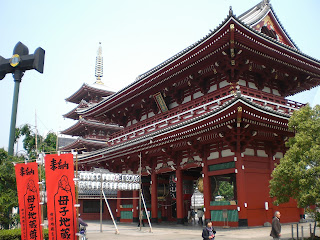Getting through passport control when we arrived at Tokyo took about an hour and a half. The queue zigzagged backwards and forwards until we finally got to the desk, were fingerprinted and photographed and issued with our visas. Then, after collecting our luggage, we negotiated the Tokyo metro and subway system to our booked hotel in Asakusa. We had to change trains just once but need the help of locals to find the right platforms. Most seem to be able to understand English even if they can't speak it.
The Chisun Inn is a modern hotel with small but very well appointed rooms. The only downside of our room is that the window faces onto a blank wall about 1.5 metres away. Most of the 200 hundred rooms are the same as the 10 storey building is wedged on 3 sides between other high rise buildings.
After a comfortable night's sleep we went in search of a place where we could get breakfast with a vegetarian option for Gail. In the end we resorted to Macdonalds, where she could have hotcakes, then as we left we noticed a cafe opposite that did a rice and salad breakfast plate. perhaps we'll go there tomorrow and I'll have a more traditional Japanese breakfast than Maccas bacon and egg between two hotcakes which is their version of the MacMuffins we get at home.
Then we explores Asakusa on foot. First Japan's oldest Buddhist temple, the Sensouji Temple dedicated to the goddess Kannon, which was first built in 628. It is entered through the Kaminarimon Gate which has a huge lantern flanked by the gods Fujin (god of wind) on the right and Raijin (god of thunder) on the left.
Through the gate is a market street selling mainly touristy stuff and then the temple itself.
To the right of the temple is the Asakusa Shrine, a Shinto shrine dedicated to protecting the Buddhist Temple in a typical Japanese arrangement.
Then we walked to Kappabashi-dori, the restaurant and hotel wholesale district where for about a kilometre the shops sell cooking equipment and the plastic food that Japanese restaurants arrange on plates in their windows to show what delights can be eaten within.




No comments:
Post a Comment